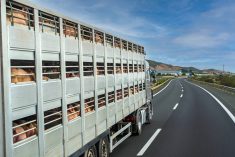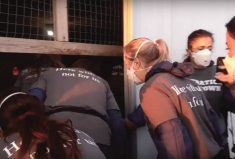Practising low-stress handling techniques has its benefits — it may actually help reduce shrink during transportation.

“It’s about how we set animals up to interact with humans — any time you interact with them you’re training them how to respond and what to expect from humans,” said Christy Goldhawk who did her doctorate work on cattle transportation and is now a global adviser for animal health and welfare for Elanco Animal Health.
Proper handling will train an animal to remain calm, she said.
“If you can, train them to move away from people, expect low stress, (and not to) freak out, when it comes time to put them through a handling system or get them to go on a truck, you’re probably going to be better off,” she said.
Dr. Karen Schwartzkopf-Genswein agrees.
Read Also

Pig transport stress costs pork sector
Popular livestock trailer designs also increase pig stress during transportation, hitting at meat quality, animal welfare and farm profit, Agriculture and Agri-Food Canada researcher says
Rough and excessive handling, along with working animals in extreme conditions can all increase shrink, said Schwartzkopf-Genswein, senior research scientist on beef welfare and behaviour at Agriculture and Agri-Food Canada’s Lethbridge Research Centre.
“Although most good cattlemen know those things anyway, we don’t have numbers to show that if you do things ‘this way’ the shrink is less (or) if you handle less, the shrink is less,” she said.
When it comes to loading, give animals time and don’t put people in situations where they can get hurt, said Goldhawk.
“When it comes time to load, be cautious about what you’re doing,” she said. “Be kind about it, give the animal some time to investigate. You need to be conscious of where your body is and what it might be blocking from that animal or what you might inadvertently be asking that animal to do.”
You should also assess whether an animal is fit for transportation.
“Complaints about transport are still the greatest number of complaints to the minister of agriculture,” said Schwartzkopf-Genswein. “It’s a highly visible thing the industry does.”
“Make sure they are well hydrated and they’ve had water and feed and that kind of support before they get on the truck for the type of journey they are going on,” Goldhawk added.
The type of feed provided prior to transport will also affect the amount of shrink. A Montana study found cattle on grass or fed silage shrunk more than those fed concentrates, and cattle on free-choice feed and water had lighter morning weights than evening weights.
The study also found cattle not familiar with enclosures shrunk more than five per cent when held in dry lots overnight, prior to transport. It is recommended that cattle have good dry hay rations before being shipped and to avoid extreme washy, lush feeds.
The temperature inside the trailer is important too. One of Goldhawk’s studies compared temperature and humidity inside the trailer.
“What was actually happening was open boarding pattern (no boards) had more humidity within the trailer than something that had partial boards,” she said. “The boards are actually allowing a better air exchange as the truck is moving, reducing the humidity level. With cold weather transport, it comes down to what they’re used to and the change in what they are used to.”
Another of her studies found shrink was higher for calves hauled in trailer temperatures below 5 C.
Other factors
In a recent collaboration on the winter transport of finished cattle with the University of Manitoba, Schwartzkopf-Genswein and her colleagues found shrink increased by an additional one per cent for journeys of more than 300 kilometres. And when load densities increased from one animal per square metre to 2.5 animals per square metre, shrink increased by 2.7 per cent. And when the temperature/humidity index approached 0 C, shrink increased by 2.3 per cent.
As well, different classes of animals handle transportation differently.
“The research indicates the pre-conditioned calves and fat cattle shrink less,” said Goldhawk.
For feeders, cull cows, and calves ‘weaned on the truck’ (sent to market immediately after being removed from their mothers), it all comes down to how those animals are prepared for the trip.
Some calves weaned on the truck come out the same with shrink, if not better than pre-conditioned calves, but others don’t handle the transportation very well, said Goldhawk.
Once again, it comes back to how the animals were managed ahead of time, she said.
“Were they prepared for that journey in terms of nutrition, hydration, and handling? And how were they managed during that journey — was there a factor in there like really high temperatures that they aren’t used to? Did that cause them to not cope with those conditions so well?”
Many studies on shrink focus on fat cattle but well-conditioned cattle are “very robust in how they can manage stress,” said Schwartzkopf-Genswein.
“We didn’t see significant amounts of shrink or any amounts of major hardships for those animals.”
However, feeder cattle are another story.
In one study, Schwartzkopf-Genswein and a colleague found shrink levels for feeder cattle to be 7.9 per cent (well above the level for fat cattle, which typically have shrink of five per cent or less).
The study also found that shrink was greater for feeder cattle loaded at the farm, ranch, or feedlot versus the auction market.
The time of day when loading and driver experience also affect shrink, according to the same study. Cattle loaded in the afternoon and evening exhibited more shrink than those loaded in the night or morning. Shrink was also lower on loads where the truck driver had six or more years of experience hauling livestock.
The bottom line is that there are ways to reduce shrink — and put more money in your pocket.
“It comes down to thinking about ‘What is shrink?’ And being active about how you apply it,” Goldhawk said. “Shrink is really happening because there is nothing going in and energy going out. So what can you do to reduce that cost of the energy going out?”
This article was originally published on the Alberta Farmer Express.



















